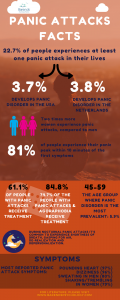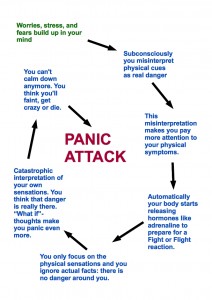What causes a panic attack?
There are many different panic attack causes, and it’s impossible to tell which one causes panic disorder. As a matter of fact, more and more research shows that the panic attack causes can be found in genetic and environmental factors, such as possessing certain genes and/or experiencing traumatic events. This page discusses scientific evidence that explains why both environmental and genetic factors partially contribute to the development of panic disorder. Please note, however, that having family members with an anxiety disorder, or having experienced childhood traumatic events, does not mean that a person will develop panic disorder; they are panic attack causes, but it only increases the chance for someone to develop panic disorder.
For those who do not know how to stop panic attacks themselves, we offer (online) counseling for panic attacks and panic disorders. Contact us straight away for an appointment. (Depending on your health insurance, sometimes treatment can be reimbursed).
Quick Jump-to menu:
Panic attack causes – Genetics
There are a lot of scientific articles linking certain genes to the increased chance of developing panic disorder. The heritability of panic disorder is moderate (ranging from 31 to 88%) [2]. An overview:
Study [4] found shared genetic determinants to be the major underlying cause of the developmental continuity of childhood separation anxiety disorder into adult panic disorder [4]. One such determinant could be the monoamine oxidase A allele. Among German and Italian females with panic disorder (participated in study [6]), researchers found significantly longer alleles (3a, 4, and 5), compared to German and Italian females without panic disorder. Reduced monoamine oxidase A activity is associated with impulsiveness and aggressiveness in humans, but it is unclear to which panic disorder symptom (panic attacks, anticipatory anxiety or phobic avoidance) monoamine oxidase A contributes [6]. Another such factor could be the personality trait neuroticism [10]; researchers founds the genes responsible for neuroticism to be present in people with internalizing disorders, such as panic disorder. People who score high on neuroticism are more sensitive to symptoms of stress, anxiety, and panic.
In study [5], researchers found a moderate total heritability of 41 to 44%. This is in line with findings from other studies where researchers found that when one twin has panic attacks, the other twin has a bigger chance (ranging from 31-88%) of having an anxiety disorder [2]. Another study demonstrated that more than 90% of the probands and first-degree relatives with panic disorder also had an affective disorder diagnosis, such as bipolar disorder [7]. (Probands are the first in the family tree to develop a certain mental disorder). Also, another study found a link between panic disorder and the ADORA2A gene [8], which has been reported in several studies.
There is a high genetic corrolation between generalized anxiety disorder (GAD) and panic disorder: 0.83, which suggests a common etiology between panic disorder and GAD [12]. The connection between GAD and panic disorder is further supported by study [1] where researchers found GAD symptoms to be responsible for 37.9% for panic disorder symptoms and PTSD symptoms. The panic disorder symptoms were responsible for 20.7% for the GAD symptoms and PTSD symptoms [1].
Panic attack causes – Brain
People with panic disorder display a strong conditioned fear generalization compared to people without panic disorder. According to study [3], panic people react stronger to less threatening information compared to healthy people. This overgeneralization could lead to encounter more panic reminders in the days/weeks/months following a panic attack.
Panic attack causes – Environment
Environmental factors partially explain the development of panic disorder and its symptoms. Also, traumatic experiences seem to be a predictor of the onset of panic disorder [11].
Researchers found that life experiences with other relatives or alone increase the risk of developing panic disorder [9]. A modest relationship between shared environmental risk factors and neuroticism and internalizing disorders [10] was found in a twin study, which suggests that experiencing the same events increases the development of internalizing disorders (such as panic disorder), but not as much as genes do. NOTE: by life experiences they mean those that negatively affect someone’s life.
Significantly more people with panic disorder, compared to people without a psychiatric disorder, report traumatic childhood experiences (68.7% versus 37.1%), reported the attitude of their parents as more restrictive, and providing less love, care, and attention [11]. Also, there were more psychiatric disorders present in the families of those with panic disorder [11]. A connection between PTSD and panic disorder has also been found in study [1]; 21.3% of the PTSD symptoms could explain panic disorder symptoms, and [13] where 24.1% of women and 5% of men with panic disorder reported a history of being sexually molested.
(Advertisement. For more information, please scroll down.)
Literature:
- [1] Chantarujikapong, S. I., Scherrer, J. F., Xian, H., Eisen, S. A., Lyons, M. J., Goldberg, J., … & True, W. R. (2001). A twin study of generalized anxiety disorder symptoms, panic disorder symptoms and post-traumatic stress disorder in men. Psychiatry research, 103, 133-145.
- [2] Hettema, J. M., Neale, M. C., & Kendler, K. S. (2001). A review and meta-analysis of the genetic epidemiology of anxiety disorders. American Journal of Psychiatry, 158, 1568-1578.
- [3] Lissek, S., Rabin, S., Heller, R. E., Lukenbaugh, D., Geraci, M., Pine, D. S., & Grillon, C. (2009). Overgeneralization of conditioned fear as a pathogenic marker of panic disorder. American Journal of Psychiatry, 167, 47-55.
- [4] Battaglia, M., Pesenti-Gritti, P., Medland, S. E., Ogliari, A., Tambs, K., & Spatola, C. A. (2009). A genetically informed study of the association between childhood separation anxiety, sensitivity to CO2, panic disorder, and the effect of childhood parental loss. Archives of general psychiatry, 66, 64-71.
- [5] Kendler, K. S., Walters, E. E., Neale, M. C., Kessler, R. C., Heath, A. C., & Eaves, L. J. (1995). The structure of the genetic and environmental risk factors for six major psychiatric disorders in women: Phobia, generalized anxiety disorder, panic disorder, bulimia, major depression, and alcoholism. Archives of general psychiatry, 52, 374-383.
- [6] Deckert, J., Catalano, M., Syagailo, Y. V., Bosi, M., Okladnova, O., Di Bella, D., … & Maier, W. (1999). Excess of high activity monoamine oxidase A gene promoter alleles in female patients with panic disorder. Human molecular genetics, 8, 621-624.
- [7] MacKinnon, D. F., Zandi, P. P., Cooper, J., Potash, J. B., Simpson, S. G., Gershon, E., … & DePaulo, J. R. (2002). Comorbid bipolar disorder and panic disorder in families with a high prevalence of bipolar disorder. American Journal of Psychiatry, 159, 30-35.
- [8] Hamilton, S. P., Slager, S. L., De Leon, A. B., Heiman, G. A., Klein, D. F., Hodge, S. E., … & Knowles, J. A. (2004). Evidence for genetic linkage between a polymorphism in the adenosine 2A receptor and panic disorder. Neuropsychopharmacology, 29, 558.
- [9] Hettema, J. M., Prescott, C. A., Myers, J. M., Neale, M. C., & Kendler, K. S. (2005). The structure of genetic and environmental risk factors for anxiety disorders in men and women. Archives of general psychiatry, 62, 182-189.
- [10] Hettema, J. M., Neale, M. C., Myers, J. M., Prescott, C. A., & Kendler, K. S. (2006). A population-based twin study of the relationship between neuroticism and internalizing disorders. American journal of Psychiatry, 163, 857-864.
- [11] Bandelow, B., Späth, C., Tichauer, G. Á., Broocks, A., Hajak, G., & Rüther, E. (2002). Early traumatic life events, parental attitudes, family history, and birth risk factors in patients with panic disorder. Comprehensive Psychiatry, 43, 269-278.
- [12] Mosing, M. A., Gordon, S. D., Medland, S. E., Statham, D. J., Nelson, E. C., Heath, A. C., … & Wray, N. R. (2009). Genetic and environmental influences on the co‐morbidity between depression, panic disorder, agoraphobia, and social phobia: a twin study. Depression and anxiety, 26, 1004-1011.
- [13] Leskin, G. A., & Sheikh, J. I. (2002). Lifetime trauma history and panic disorder: findings from the National Comorbidity Survey. Journal of Anxiety Disorders, 16, 599-603


